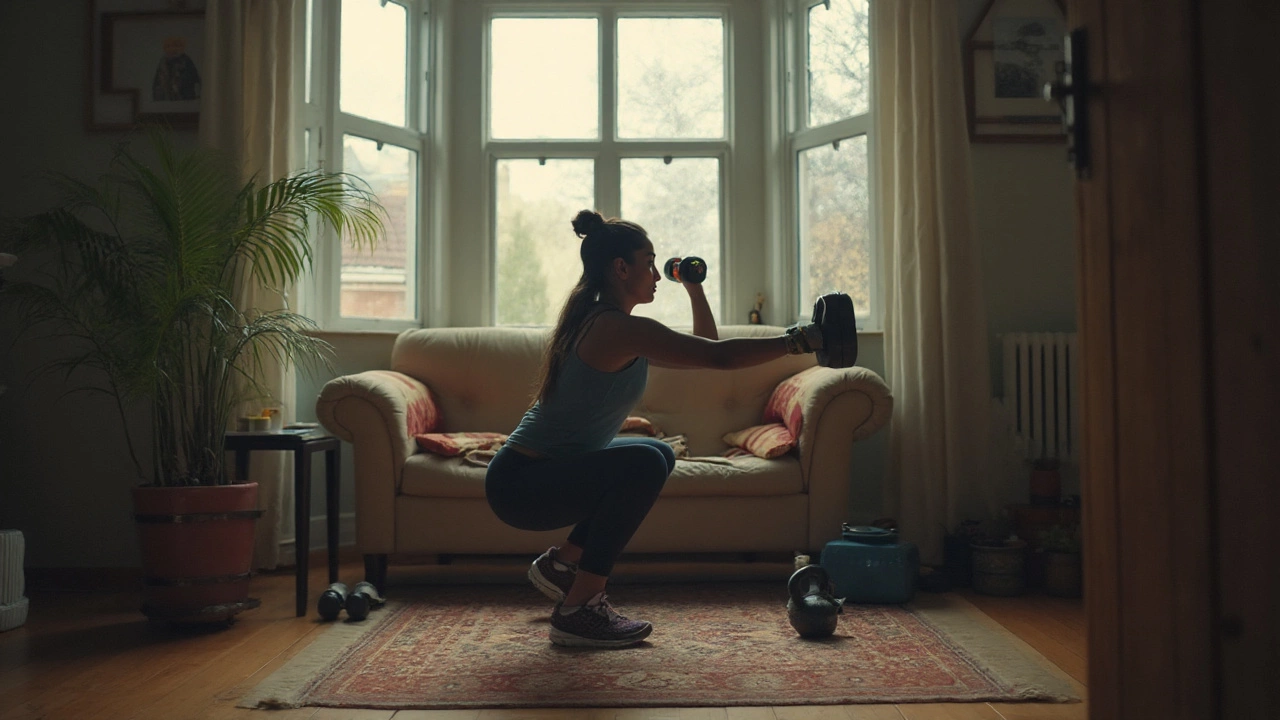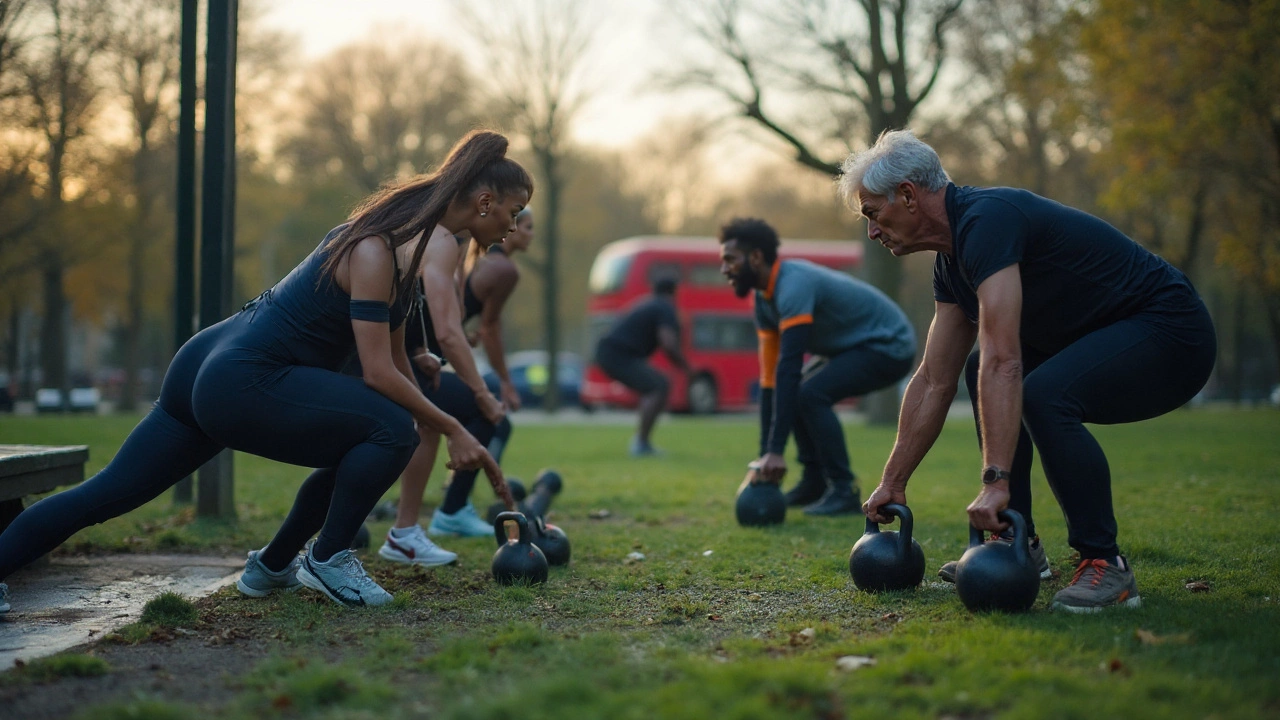You don’t need a 12-move circuit to get fit. If you pick the right four moves and do them hard, you can build strength, muscle, and conditioning without living in the gym. I’m a dad in Adelaide with a kid who hijacks my evenings (cheers, Finn), so I built my week around short, focused sessions. Here’s the honest answer: yes, four exercises can be enough-if you hit the big patterns, train with intent, and plan your week properly.
- TL;DR: Four exercises can cover your whole body if they hit squat, hinge, push, and pull.
- Do 2-4 hard sets per exercise, 8-12 reps most of the time, and push near technical failure (1-3 reps in reserve).
- Train 2-3 times per week; aim for ~10-15 hard sets per muscle group per week for growth, 6-10 for maintenance.
- Choose big compound lifts (e.g., squat, deadlift/hip hinge, press, row/pull-up). Rotate variations across the week.
- Four moves won’t cover marathon cardio, but you can add 1-2 short conditioning blocks or steps to fill the gap.
What “enough” really means: volume, intensity, and frequency
“Enough” isn’t about how many exercises you list on a whiteboard. It’s about the training dose your body needs to adapt: how many hard sets you do, how close to failure you take them, and how often you train each pattern.
Evidence you can hang your hat on:
- The WHO’s adult guidelines: resistance training at least 2 days per week for major muscle groups; 150-300 minutes of moderate cardio or 75-150 minutes vigorous weekly.
- ACSM’s resistance training position stands: 2-4 sets per exercise, 8-12 reps, working near failure for strength and hypertrophy.
- Volume matters most for size: meta-analyses (Schoenfeld 2017; updated papers through 2022) suggest ~10-20 hard sets per muscle per week drives growth. Maintenance is lower, ~6-10 sets.
- Frequency matters less when volume is matched: whether you train a muscle 1-3+ times per week, similar gains if total weekly sets are the same (Baz-Valle 2022 review in trained lifters).
So, can four moves be “enough”? Yes-if those four moves are big compounds that load a lot of muscle at once, and you accumulate enough weekly hard sets.
Simple targets that work:
- Intensity: finish most sets with 1-3 reps in reserve (RIR). That’s hard but clean, not sloppy.
- Reps: mostly 6-12 for muscle, 3-6 for strength, 12-20 to push work capacity. Mix as needed.
- Rest: 90-180 seconds for big lower and heavy pushes/pulls; 60-90 seconds for accessories or lighter work.
- Time: four exercises × 2-4 sets each = 20-35 minutes if you keep rests honest.
| Goal | Weekly hard sets (per muscle) | Rep range | Rest | Are 4 moves/session enough? |
|---|---|---|---|---|
| General fitness/health | 6-10 | 8-15 | 60-120s | Yes, with 2-3 sessions/week |
| Muscle gain (hypertrophy) | 10-15 (up to 20 if advanced) | 6-12 (plus some 12-20) | 90-180s | Yes, if you rotate variations and hit weekly volume |
| Strength (numbers go up) | 8-12 quality sets of the key lift | 3-6 (top sets), 6-8 (back-off) | 120-240s | Yes, prioritise one main lift per day |
| Fat loss (with diet) | 6-12 (maintain muscle) | 8-15 | 60-120s | Yes, add steps/short conditioning |
A single session with four moves won’t cover every angle. Across the week is where you make it “enough.”
The 4-move framework that covers your whole body
Think movement patterns, not body parts. Hit these, and you’re covered:
- Squat pattern (knee-dominant): back/front squat, goblet squat, split squat, leg press, step-up.
- Hinge pattern (hip-dominant): deadlift, Romanian deadlift, hip thrust, kettlebell swing, good morning.
- Push (upper): horizontal push (bench, push-up, dumbbell press) and/or vertical push (overhead press, landmine press).
- Pull (upper): horizontal pull (row) and/or vertical pull (pull-up/lat pulldown).
Optional: add a carry or core finisher if time allows-farmer’s carry, plank/side plank, Pallof press. But you don’t have to, if you rotate push/pull angles across the week.
Smart swaps by equipment:
- No barbell? Use dumbbells or kettlebells: goblet squat, DB RDL, DB bench, 1-arm row.
- No weights? Do pistol box squats to a chair, hip bridges/hip thrusts, push-ups, inverted rows or band rows.
- Shoulder cranky? Use landmine press or incline push-up. Hips tight? Try split squats instead of deep back squats.
The trick is rotating variations across the week so joints get a break and muscles see slightly different angles. Monday might be front squat and bench; Thursday could be RDL and overhead press; Saturday you pull up and single-leg squat.

Ready-to-use 4-exercise routines (20-35 minutes)
You’ve got goals and a calendar. Pick the template that fits, then stick with it for 6-8 weeks before changing too much. Train hard, log your sets, and add a little weight or reps each week.
These are built around one rule: each session hits 4 big moves. Adjust loads so the last rep of each set leaves 1-3 reps in reserve.
Template A: 3 days/week (Mon-Wed-Sat)
- Day A
- Front Squat or Goblet Squat - 3-4 × 6-10
- Bench Press or Push-Up (weighted if strong) - 3-4 × 6-10
- Romanian Deadlift - 3-4 × 6-10
- 1-Arm DB Row or Chest-Supported Row - 3-4 × 8-12
- Day B
- Deadlift (or Trap Bar DL) - 3-5 × 3-6
- Overhead Press or Landmine Press - 3-4 × 5-8
- Split Squat or Reverse Lunge - 3-4 × 8-12/leg
- Pull-Up/Chin-Up (assisted if needed) - 3-5 × 5-8
- Day C
- Hip Thrust or KB Swing - 3-4 × 8-12 (or 12-15 for swings)
- Incline DB Press - 3-4 × 8-12
- Row Variation (cable or barbell) - 3-4 × 8-12
- Single-Leg Squat to Box or Step-Up - 3-4 × 8-12/leg
Why it works: across the week you tick the squat, hinge, push, and pull patterns multiple times with different angles. Most people land 12-16 hard sets per major muscle-bang in the sweet spot.
Template B: 2 days/week (Tue-Fri)
- Day 1
- Back Squat or Leg Press - 4 × 5-8
- Bench Press or Push-Up - 4 × 6-10
- Romanian Deadlift - 3-4 × 6-10
- Row (1-arm, chest-supported, or cable) - 4 × 8-12
- Day 2
- Deadlift (heavy) or Hip Thrust (moderate) - 4 × 3-6 (DL) or 4 × 8-12 (thrust)
- Overhead Press or Landmine Press - 4 × 5-8
- Split Squat or Step-Up - 3-4 × 8-12/leg
- Pull-Up/Lat Pulldown - 4 × 6-10
Why it works: two well-chosen sessions still cover the big patterns. You’ll hit 8-12 sets per muscle-enough for maintenance and progress for most intermediates. Add a third day later if you stall.
Template C: Home-only, 20 minutes (no equipment or bands)
- Bulgarian Split Squat to chair - 3 × 10-15/leg (3-0-1 tempo)
- Push-Up - 4 × 8-15 (elevate feet or add backpack if strong)
- Hip Bridge/Hip Thrust (single-leg if strong) - 3-4 × 10-20
- Inverted Row (sturdy table) or Band Row - 4 × 8-15
Progress by slowing the lowering phase (3-4 second eccentrics), pausing at the bottom, or adding a backpack. If you’ve got a kettlebell, swap in swings for hip drive.
How to pick reps and loads
- Muscle focus: 3-4 sets of 8-12 reps, last 2-3 reps tough.
- Strength focus: 1-2 top sets of 3-5 reps, then 2-3 back-off sets at 6-8 reps.
- Fat-loss focus: stick to 8-15 reps, short rests (60-90s), keep moves big; let diet and steps handle the deficit.
Progression rule of thumb: when you hit the top of the rep range on all sets with good form, add 2.5-5 kg next time (or add a rep per set). For bodyweight, make it harder (elevate feet, slower tempo, pauses) before adding volume.
Programming that fits real life (and still works)
Time is the bottleneck, not your genetics. Here’s how to squeeze results from short sessions.
- Warm up fast: 3-5 minutes brisk walk or row, then one light set + one moderate set of your first two moves. Save your energy for the work sets.
- Superset smart: pair non-competing moves (e.g., squat with row) to save time without tanking performance. Rest 30-60s between exercises, 60-120s between rounds.
- Track RIR: if your last set never dips under 3-4 reps in reserve, you’re leaving progress on the table.
- Microload: small jumps (2.5 kg total on barbell, 1 kg per DB) beat ego jumps. Progress is progress.
- Rotate angles: horizontal press one day, vertical the next. Same for pulls. Hips: RDL one day, thrust or swing the next.
- Cardio: aim for 6-10k steps daily. Add two 10-15 minute finishers per week (bike sprints, incline walk, kettlebell swings EMOM) if conditioning matters to you.
- Recovery basics: 7-8 hours sleep if you can; protein at ~1.6-2.2 g/kg bodyweight per day; move your long walks on non-lifting days.
Evidence notes you can trust:
- Strength and size are driven by proximity to failure and total weekly sets (Schoenfeld 2017; Grgic 2022).
- Frequency is a logistics tool more than a magic bullet when volume is equated (Baz-Valle 2022).
- Short sessions can match long ones if set quality and load are high (multiple lab trials 2018-2023 in trained and untrained adults).
Reality check from my week: on nights when sport drop-offs steal the clock, I run a tight 25-minute block-front squat, bench, RDL, row. If I hit my numbers, it counts. If I miss, I slide the day, not the plan.

Checklists, answers, and real-world troubleshooting
Here’s how to stress less and get results with only four moves.
The 4-Exercise Planner (printable checklist)
- Pick your four: 1 squat, 1 hinge, 1 push, 1 pull.
- Set the dose: 2-4 sets each, 6-12 reps (tweak per goal).
- Choose the load: last set ends 1-2 RIR.
- Lock the schedule: 2-3 days this week with at least 48h before repeating heavy hinges.
- Progression: add 1 rep or 2.5-5 kg next time if you hit the top of the range.
- Notes: log sets, RIR, and how it felt. Adjust next week.
Common pitfalls to dodge
- Four random moves: if you miss a pattern, something won’t grow. Use the framework.
- Never training near failure: “easy” sets won’t drive adaptation. Keep 1-3 RIR.
- Too many isolation moves: they eat time without covering much muscle. Save curls for the end or another day.
- Same angles forever: change push/pull angles across the week to cover shoulders and elbows.
- No deloads: every 6-8 weeks, halve the sets or cut load by ~10% for one week.
Mini‑FAQ
- Is a four exercises workout enough to build muscle? Yes, if those moves are big compounds and you hit ~10-15 hard sets per muscle per week across 2-3 days.
- What about abs? Big compounds train your trunk, but add 2-3 sets of planks or Pallof presses after if you want. Or rotate a core finisher into one of your four slots every second week.
- Do I need cardio? For heart health and fat loss, yes. Add steps and 1-2 short finishers per week, or a 30-minute brisk walk on non-lifting days.
- I’m a beginner-still okay? Perfect. Learn the patterns with lighter loads and more reps (8-12). Keep form crisp. You’ll progress fast.
- I’m advanced-still enough? If you’re chasing elite numbers or bodybuilding detail, you’ll likely need more total sets and some targeted accessories. Use the four as your base, then add 1-2 extras.
- How long until I see results? Strength often jumps in 2-4 weeks from neural gains; visible muscle changes 6-12 weeks with good sleep and protein.
- What if my joints ache? Swap the variation (e.g., landmine press, split squats), reduce range slightly, and back off load for a week. Pain that lingers-see a physio.
Next steps
- Pick your template (2 or 3 days) and slot it into your calendar this week.
- Choose one squat, one hinge, one push, one pull you can do safely now.
- Run it for 6 weeks. Track loads, reps, and RIR. Add small progress weekly.
- Week 7: deload or swap angles (e.g., bench → incline DB, RDL → hip thrust).
Troubleshooting by scenario
- Time-crunched (15 minutes): do 2 sets per move, use supersets (squat+row, hinge+press). Keep rests to 60-90s. Add one 10-minute walk later.
- No equipment: pick C template; push tempo (3-second lowers, pauses). Elevate feet for push-ups, single-leg bridges for glutes.
- Stalled progress: add 1-2 weekly sets to the lagging pattern for 3-4 weeks, then deload. Or split the week into 3 days to increase frequency.
- Fat-loss block: keep loads heavy enough to leave 1-2 RIR; don’t chase burn at the cost of form. Let diet and steps create the deficit.
- Travel week: choose four hotel-friendly moves (split squat, push-up, hip bridge, inverted row) and run EMOM: 8-10 minutes x 2 blocks.
Final thought from a busy Adelaide dad: when my session shrinks, I don’t cancel-I compress. Four big moves, done hard, and I’m back in time for homework duty. Keep it simple, keep it honest, and the results stack up.






